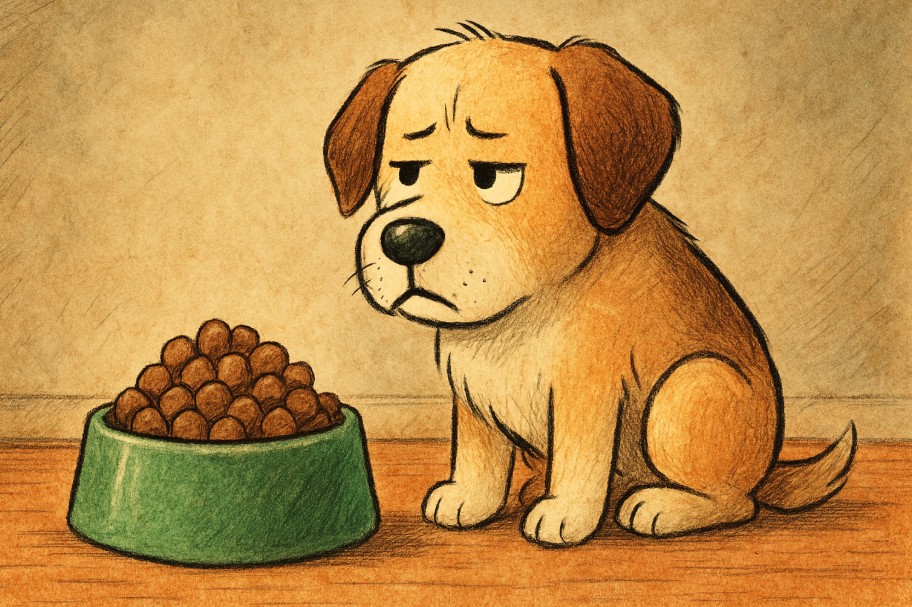Why is My Dog Not Eating His Food but Will Eat Treats?
Every dog owner has faced this frustrating question at some point: Why is my dog not eating his food but will eat treats? It’s a scenario that raises both concern and confusion.
Dogs thrive on routine, and when that routine is disrupted, especially with eating, it’s often a signal that something isn’t quite right.
Whether it’s a matter of preference, behavioural conditioning, medical discomfort or stress, understanding the underlying cause is vital.
This blog breaks down everything you need to know, from natural feeding behaviour to medical red flags, long-term effects, and practical strategies to get your dog back to balanced eating.
With expert-backed advice and practical tips, you’ll be better equipped to support your dog’s health and prevent this pattern from becoming a habit.
What Should You Know About a Dog’s Natural Eating Behaviour?
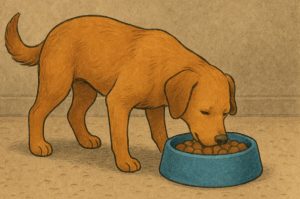
Dogs, by nature, are creatures of habit. In a healthy routine, they tend to eat at consistent times and typically finish their meals quickly.
Puppies often have a stronger appetite than older dogs, while senior dogs might slow down due to changes in metabolism or dental health.
Breed also plays a part, for instance, Labradors are known to be voracious eaters, while smaller breeds like Chihuahuas can be pickier.
It’s essential to observe your dog’s usual behaviour to identify changes early. A naturally enthusiastic eater turning indifferent to their meals may indicate an underlying issue. Additionally, dogs are instinctive scavengers.
In the wild, food scarcity shaped their eating behaviours. In domestic settings, this may translate into excitement over treats which are high-value and flavour-packed compared to regular meals.
Routine, consistent feeding and a calm environment during mealtimes help dogs develop predictable eating habits.
Disruptions, such as moving home or schedule changes, can influence this routine. Understanding what is normal for your dog is the first step to identifying when things go off track.
How Do Dogs Form Preferences Between Food and Treats?
Dogs often choose treats over food due to taste, smell, and texture. Treats are generally richer, more aromatic, and have higher fat content than regular kibble or wet food.
These factors trigger a more positive reward response in the brain, making treats more appealing. Over time, if a dog learns that ignoring their meal results in getting treats instead, they will repeat this behaviour.
This preference isn’t always about spoiling or bad training. It can be conditioned unintentionally.
For instance, if a dog is rewarded with a treat after refusing food, they learn that refusing leads to something tastier. Their preference then becomes reinforced over time.
Some dogs also crave variety. Eating the same kibble daily might become monotonous, especially when treats introduce different flavours.
Understanding this helps owners realise that a preference for treats isn’t a personality flaw it’s a response to stronger flavours, inconsistent reinforcement, and sometimes boredom.
What Symptoms Indicate That My Dog’s Eating Habits Are a Cause for Concern?

While it’s normal for dogs to skip a meal occasionally, consistent refusal to eat regular food while still accepting treats should raise a red flag.
Dogs can’t communicate discomfort directly, so their eating behaviour becomes a major indicator of their health.
Signs of Concern: When to Worry About Your Dog’s Health
- Sudden loss of interest in all types of food
- Rapid weight loss
- Lethargy or low energy levels
- Vomiting or diarrhoea
- Drooling, pawing at the mouth, or signs of dental pain
- Sniffing food but walking away
- Only eating when hand-fed
If your dog displays any of these signs alongside food refusal, a medical check-up is essential. Appetite loss could be linked to dental disease, gastrointestinal issues, infections, kidney problems, or even more severe conditions like cancer.
Ignoring the signs can lead to worsening health. It’s crucial to differentiate between behavioural pickiness and medical distress.
Early identification makes treatment and recovery easier, ensuring your dog maintains a healthy, happy lifestyle.
Why is My Dog Not Eating His Food but Will Eat Treats?
Before addressing your dog’s selective eating, it’s essential to identify the potential factors influencing their behavior.
Dogs may refuse their meals for various reasons, including health problems, environmental stressors, or personal food preferences. Identifying the root cause is crucial for finding an appropriate solution.
Below, we explore some common reasons why your dog may not be eating their regular food while still enjoying treats.
Health Issues
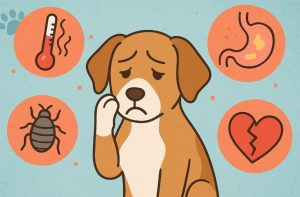
Certain health conditions can cause a dog to lose interest in their usual meals but still accept treats. These issues can range from minor discomforts to severe illnesses, all of which require careful observation and veterinary attention.
1. Dental Problems
Dental issues can make chewing painful, leading your dog to avoid their regular kibble while still accepting softer treats.
Conditions like gum disease, tooth decay, oral infections, or broken teeth can create discomfort, discouraging them from eating. Regular dental check-ups and proper oral hygiene are essential in preventing these issues.
2. Digestive Disorders
Gastrointestinal problems such as gastritis, colitis, pancreatitis, or irritable bowel syndrome can make eating uncomfortable or even painful.
These conditions often result in nausea, vomiting, or diarrhea, leading your dog to be selective with food. A veterinarian may recommend dietary changes or medications to manage these issues effectively.
3. Kidney Disease
Kidney disease affects your dog’s ability to filter toxins from the blood, which can lead to nausea, lethargy, and a decreased appetite.
Dogs with kidney issues may refuse dry food but might still eat wet food or treats. Early diagnosis and proper dietary management can help maintain their quality of life.
4. Neurological Conditions
Disorders affecting the nervous system, such as seizures, brain tumors, or cognitive dysfunction in senior dogs, can interfere with normal eating habits.
If your dog exhibits disorientation, tremors, or difficulty chewing, it’s important to seek veterinary care to determine the cause and provide appropriate treatment.
5. Respiratory Infections
Respiratory illnesses, including kennel cough, pneumonia, or nasal infections, can make breathing difficult, reducing your dog’s ability to smell and taste food.
Since scent plays a major role in a dog’s appetite, congestion may lead to food refusal. Treating the underlying infection can help restore their interest in eating.
6. Pain and Discomfort
Pain from conditions such as arthritis, injuries, or internal inflammation can reduce your dog’s willingness to eat. If your dog is avoiding their food but still consuming treats, it could indicate that chewing or posture-related pain is affecting their appetite.
Pain management strategies, such as anti-inflammatory medications, can help restore normal eating behavior.
If your dog continues to reject their meals but accepts treats, monitor their behavior closely and consult a veterinarian for a thorough evaluation.
Changes in Environment or Routine
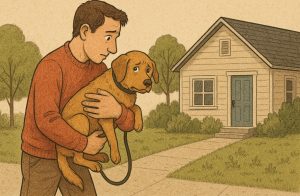
Dogs thrive on consistency, and sudden changes in their environment or daily schedule can disrupt their eating habits.
Stress and anxiety from these changes can lead to a temporary loss of appetite, making it important to maintain stability in their surroundings.
1. Moving to a New Home
Relocating to a different home can be stressful for dogs, as they must adjust to unfamiliar sights, smells, and sounds.
Some dogs may stop eating altogether until they feel comfortable in their new environment. Creating a familiar space with their bedding, toys, and routine can help ease the transition.
2. New Pets or Family Members
The introduction of a new pet, a newborn baby, or even a frequent house guest can cause stress, leading to changes in eating habits.
Dogs may feel territorial or anxious, resulting in reduced interest in their regular food. Gradual introductions and reassurance can help them adjust to new additions.
3. Changes in Feeding Schedule
If meal times have shifted due to a change in your work schedule or daily routine, your dog may take time to adapt.
Dogs are creatures of habit, and any alteration in their feeding schedule can temporarily affect their appetite. Consistency and patience are key to helping them settle into the new routine.
4. Separation Anxiety
Dogs that experience separation anxiety may refuse to eat when left alone or when their primary caregiver is absent.
This behavior is common in dogs who form strong bonds with their owners. Implementing calming techniques, such as leaving comforting items or providing interactive toys, can help reduce anxiety and encourage eating.
Maintaining a stable and stress-free environment can significantly impact your dog’s eating habits. If changes are unavoidable, gradual transitions and extra attention can help them adjust.
Food Preferences
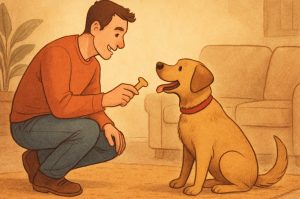
Just like humans, dogs have personal preferences when it comes to food. The taste, texture, and smell of their meals can influence whether they eat enthusiastically or refuse their food. If your dog eagerly eats treats but ignores their meals, they may simply be a picky eater.
1. Texture and Smell Sensitivity
Some dogs prefer wet food over dry kibble due to its stronger aroma and softer texture. Others may favor crunchy food over soft varieties.
If your dog turns away from their usual food, experimenting with different textures may help determine their preference.
2. Ingredient Preferences
Dogs can develop specific taste preferences based on the ingredients in their food. High-quality proteins such as chicken, beef, or fish are often more appealing than processed fillers.
If you recently switched to a new brand, your dog might not like the new formulation. Gradually mixing the old and new food can ease the transition.
3. Previous Human Food Exposure
If your dog has been fed table scraps or human food, they may begin rejecting their dog food in favor of tastier, seasoned alternatives.
Reducing access to human food and reinforcing mealtime with nutritious, balanced dog food can help curb this habit.
To encourage consistent eating, find a high-quality food that meets your dog’s nutritional needs while catering to their preferences.
Introducing new foods gradually and making meals more appealing can also help picky eaters develop better eating habits.
What To Do if Your Dog Won’t Eat Their Meals?
Getting your dog back to eating balanced meals requires consistency, patience, and small behavioural changes.
Some Effective Strategies
- Reduce treats gradually: Limit treat intake to avoid filling your dog up before meals.
- Enhance food appeal: Add a splash of warm water or low-sodium broth to bring out the smell and soften kibble.
- Set feeding schedules: Offer food at specific times and remove it after 15–20 minutes, even if uneaten.
- Use puzzle feeders: These create a fun challenge and make food more rewarding.
- Mix in wet food: Combining kibble with high-quality wet food or food toppers can increase interest.
- Keep distractions minimal: Feed your dog in a quiet, stress-free area.
- Exercise before meals: Physical activity increases hunger naturally.
By understanding your dog’s eating habits and making appropriate adjustments, you can help them maintain a balanced and nutritious diet.
If the problem persists, seeking professional advice is always the best course of action.
What Are the Possible Effects of My Dog Refusing Food Over Time?

If your dog is consistently avoiding meals, the impact can be more serious than just a bad habit. Prolonged refusal of proper meals can lead to multiple health concerns.
Key Effects to Watch For
- Nutritional deficiencies: Treats don’t contain the complete balance of nutrients found in dog food. Deficiencies can lead to poor coat condition, fatigue, and weakened immunity.
- Weight loss and muscle decline: Regular meals provide essential calories and protein for maintaining muscle mass.
- Dehydration: Some dogs reduce water intake when they don’t eat, increasing the risk of dehydration.
- Digestive issues: Irregular eating can lead to vomiting, flatulence, or constipation.
- Behavioural issues: Food anxiety or obsessive treat-seeking behaviour can arise.
It’s vital to act promptly if you notice these outcomes. A vet can help determine whether the issue is dietary, behavioural, or linked to something more serious.
Monitoring your dog’s energy, coat condition, stool, and weight helps track if meal refusal is beginning to take a toll.
What Are the Long-Term Effects of Inconsistent Eating in Dogs?
Inconsistent eating habits might seem harmless at first, but over time, they can lead to serious health and behavioural issues in dogs.
When meals are skipped or eaten irregularly, the digestive system becomes unbalanced, often resulting in bloating, gas, diarrhoea, or constipation.
This disruption affects their metabolic rhythm, making it harder for them to regulate hunger or maintain a healthy weight.
Potential Consequences of Irregular Eating
- Digestive issues: Skipping meals can lead to stomach discomfort, irregular bowel movements, and nutrient malabsorption.
- Weakened immunity: Poor nutrition and irregular feeding schedules may lower the body’s natural defences.
- Behavioural problems: Dogs may develop anxiety around food, become picky eaters, or guard meals aggressively.
Over time, these issues can affect your dog’s overall health, including coat condition, energy levels, and mood.
Establishing structured mealtimes, providing balanced nutrition, and avoiding excessive treats help prevent these long-term complications.
Should I Change My Dog’s Food to Solve the Problem?

Switching your dog’s food may help resolve picky eating, especially if boredom, sensitivity, or dislike is involved.
However, any change should be carefully considered and only made once medical issues are ruled out. Some dogs may reject food due to dental discomfort, allergies, or digestive disorders in such cases, a vet should guide your next steps.
If your dog is healthy but uninterested in their current food, it could be due to bland flavour, repeated texture, or poor quality.
Gradually introduce new food by mixing it with the old food over a period of five to seven days. This prevents stomach upset and gives your dog time to adjust to the new flavour.
Trying different types, such as switching from dry to wet food or adding variety through grain-free or gently cooked options, may restore interest. Always check that the new food meets nutritional standards. Consult your vet to confirm the best diet for your dog’s age, breed, and health needs.
What Are the Tips for Encouraging Your Dog to Eat Their Food?
Helping your dog enjoy meals again requires more than just a new brand of kibble it’s about creating the right conditions and habits that support healthy eating.
Practical Tips to Encourage Eating
- Keep meals at set times to help dogs anticipate food, making them more likely to eat without hesitation.
- Add dog-safe toppers like bone broth or plain chicken to enhance flavour and encourage a better appetite.
- Rotate food textures by mixing wet food with dry kibble or using freeze-dried options to keep meals exciting.
- Feed in a quiet spot to create a calm environment, allowing your dog to focus on eating without distractions.
- Use interactive feeders or puzzle toys to turn mealtime into a fun, engaging activity that stimulates their mind.
- Slightly warm the food to intensify its aroma, which can be especially beneficial for picky eaters.
- Offer smaller meals more frequently to accommodate dogs with smaller appetites or those feeling anxious about food.
Avoid hand-feeding or substituting food with treats. Positive reinforcement like gentle praise during meals helps build confidence and interest.
When Is It Time to Contact a Vet About My Dog’s Eating Habits?

If your dog has refused meals for more than 24 to 48 hours, and you notice unusual behaviour or physical symptoms, it’s time to contact your vet.
Prolonged appetite loss is rarely just fussiness it often points to deeper health concerns. Watch out for signs like vomiting, diarrhoea, fatigue, drooling, or difficulty chewing.
These could indicate dental problems, gastrointestinal distress, or even underlying chronic conditions.
A vet will carry out a thorough examination, which may include checking your dog’s teeth and gums, feeling for abdominal pain, or running diagnostic tests such as blood panels or x-rays.
Even if the cause is eventually determined to be behavioural, it’s essential to first rule out anything serious. Some health issues, especially in older dogs, can worsen quickly without treatment. If you’re ever unsure, it’s always better to err on the side of caution.
Early detection can make a major difference in both recovery and overall health outcomes.
How Can You Prevent My Dog from Refusing Food in the Future?
Prevention starts with building reliable, healthy eating routines from the beginning. Dogs thrive on structure, so setting the stage for consistent meals is the first step to avoiding long-term issues with food refusal.
Prevention Strategies
- Stick to a strict feeding schedule: Feeding at the same time each day helps regulate your dog’s natural appetite cycle.
- Avoid overfeeding treats or table scraps: Too many snacks between meals reduce hunger and interest in proper food intake.
- Rotate meals occasionally within the diet: Dogs appreciate variety; switching flavours or textures within the same brand can prevent boredom completely.
- Ensure regular dental care and hygiene: Painful gums or teeth are a common but preventable reason dogs avoid meals and chew less.
- Offer meals in a calm and quiet space: A peaceful feeding environment helps reduce anxiety, distractions, and unnecessary stress.
- Include mental stimulation through activities: Bored dogs may ignore food; regular play or walks can naturally boost appetite and interest.
- Schedule regular vet check-ups annually: Early detection of health issues prevents problems that may interfere with eating habits.
With these habits in place, your dog is more likely to maintain a healthy relationship with food for life.
Conclusion
If your dog prefers treats over meals, you’re not alone. This issue is more common than most realise and is often a blend of behavioural patterns and physical triggers.
By understanding your dog’s natural eating instincts and recognising when something is off, you can take informed action.
Addressing this behaviour early ensures your pet gets the balanced nutrition they need to stay healthy, active, and happy.
Use consistent routines, limit treats, and don’t hesitate to consult a vet if the issue persists. With patience and the right strategies, your dog can return to enjoying proper meals again, not just treats.
Frequently Asked Questions (FAQs)
Can exercise or lack of it affect my dog’s appetite?
Yes, dogs that are not active may not burn enough calories to feel hungry. Regular exercise naturally boosts appetite and supports digestion.
How many treats are too many for a dog in a day?
Treats should make up no more than 10% of your dog’s daily calorie intake. Excess treats can lead to obesity and meal refusal.
Can dental chews replace regular food in a dog’s diet?
No, dental chews help with oral hygiene but don’t offer complete nutrition. They should only supplement, not replace, meals.
Should I hand-feed my dog if they’re not eating?
Hand-feeding can help in short-term recovery cases. However, it should not become a routine that reinforces picky behaviour.
How do I know if my dog is just bored of their food?
If your dog sniffs the food and walks away but still eats treats, it could be food boredom. Switching flavours or textures can help.
Are there safe appetite stimulants for dogs?
Yes, but they should only be used under veterinary guidance. Over-the-counter stimulants may not be safe for every dog.
Can feeding puzzles help make food more exciting for dogs?
Yes, puzzle feeders turn meals into a game and can stimulate appetite. They also slow down eating and reduce boredom.

